#Natural Pollution Cleanup
Explore tagged Tumblr posts
Text
#bioremediation#bioremediation process#environmental pollution solutions#eco-friendly pollution control#microbial bioremediation#mycoremediation#biostimulation#natural pollution cleanup#bioremediation benefits#ecosystem restoration#pollution cleanup methods
0 notes
Text
Ocean CleanUp Launches Huge System in Pacific Garbage Patch to Clean a Football Field Every 5 Seconds https://www.goodnewsnetwork.org/ocean-cleanup-launches-system-3-to-clean-football-field-every-5-seconds/
#ocean#good news#nature#science#environmentalism#environment#ocean cleanup#sea#plastic pollution#plastic pollution solutions#great pacific garbage patch
47 notes
·
View notes
Text
youtube
Inventor Boyan Slat is on a mission to rid oceans of plastic. His team at The Ocean Cleanup designs and deploys systems that pull trash from the open ocean. Now, he’s stopping the pollution at its source: rivers where plastic is easier to catch, like those in Kingston Harbor, Jamaica.
Each year an estimated four million tons of plastic end up in the world’s oceans, killing thousands of marine creatures and accumulating up the food chain. The plastic gathers in five massive ocean gyres, the largest of which, known as the Great Pacific Garbage Patch, holds 87,000 tons of trash. After years of research, The Ocean Cleanup has created a system that removes 7000 kilograms of trash from the sea every day and a half; the team aims to remove 90% of the Great Pacific Garbage Patch by 2040.
But plastics keep flowing into the ocean, largely from the world’s polluted rivers. In Jamaica, Boyan’s team has teamed up with Alecia Beaufort and a local group cleaning up their waterways. Together, they’ve deployed a new system to trap plastic at the source as it flows downriver during a storm. Their success has inspired others to join the effort, creating a virtuous cycle of citizen action.
#Nature on PBS#wild hope#solarpunk#tidalpunk#ocean cleanup#ocean#sea#waterways#plastic#pollution#plastic pollution#jamaica#Kingston Harbor#pacific garbage patch#great pacific garbage patch#Boyan Slat#Alecia Beaufort#Youtube
5 notes
·
View notes
Text
I would love to see and be apart of initiatives like this in Jamaica. There need to be harsher penalties for pollution.
47K notes
·
View notes
Text
"Each summer, Dolphin Project hosts a worldwide event where people all over the world join in and cleanup their local beach or community – this year’s event is July 15-16, 2023!"
#beach cleaning#dolphin project#plastic pollution#trash challenge#trash tag#global beach cleanup#challenge#beach#nature#ocean
1 note
·
View note
Text
Excerpt from this story from High Country News:
The billions of dollars approved by Congress to clean up abandoned oil and gas wells have been frozen as part of President Donald Trump’s sweeping cuts to government spending, creating concerns that the cleanup will be halted just as it’s getting started.
President Trump’s barrage of executive orders included a January directive called “Unleashing American Energy,” which, among other provisions, ordered that federal agencies stop distributing money appropriated by President Joe Biden’s Inflation Reduction Act (IRA) and the Infrastructure Investment and Jobs Act (IIJA).
The Trump administration titled this section of the order “Terminating the Green New Deal.” But in freezing this congressionally approved spending, the administration halted a program that paid for plugging and reclaiming so-called “orphaned” or abandoned oil and gas wells. The order stated that agencies should “immediately pause the disbursement of funds” from those two Biden laws. It set a 90-day deadline, upcoming in April, for agencies to review their spending programs and make sure that they align with the Trump administration’s goal of increasing U.S. energy production.
The orphaned well program, which was modeled on a North Dakota initiative, had been widely used by oil states, including several in the West.
California, Colorado, Montana and New Mexico had each plugged over 100 orphaned wells using the Biden funds, according to an Interior Department report in 2024. Wyoming alone plugged 1,021 wells in just one year using federal grants.
As of last fall, the U.S. government had released over half a billion dollars in grants. Wells have been plugged in the people’s front yards, in national park areas and deep in the remote Alaskan wilderness. More than $3 billion are still left to be distributed, but previously available information about the grants appears to have been removed from the Interior Department’s website.
In response to questions from High Country News, an Interior Department spokesperson said that the grant program is “under review.”
“President Trump’s decisive actions are necessary steps to eliminate bureaucratic waste and refocus our agency on its core mission: serving the American people and managing our nation’s natural resources with integrity and efficiency,” the spokesperson said in a statement. “Orphaned wells negatively impact current and future oil and gas development activities and pose significant risk to national energy security and public safety.”
In addition to supporting jobs that address oil patch pollution, these federal dollars are used on wells that lack any owner to pay for reclamation. Left unplugged, such orphaned oil and gas wells leak huge amounts of methane into the atmosphere and can contaminate local water sources with salty water and benzene.
Now the future of that work is uncertain, in legal limbo alongside many of the Trump administration’s cost-cutting policies. The funding in question had already been appropriated by Congress, making it unclear that the Trump administration can indefinitely cancel it.
36 notes
·
View notes
Text
If we are to truly halt nature loss and protect our essential invertebrates, we must address the problems affecting all species. While light pollution continues to increase unchecked, it is our forgotten species working the night shift that will suffer the most.
Light pollution is easily preventable: turn off unnecessary lights and the problem disappears. Unlike other pollutants, there is no need for a challenging cleanup operation.
37 notes
·
View notes
Text
Sharing this on behalf of a Marine Biologist friend, not my words.
Tumblr loves sea creatures, and this is important. Have a cool pic of an octopus before digging into this big post from someone who is in the trenches (but not the really deep ones like the Mariana):

"Hi all! I have a personal request for everyone!
I need you to write a letter/email. Please write your congressional representative in support of the value that your state (or state(s) you love) Sea Grant Program means to you personally. Please send a copy of your email/letter to your state Sea Grant director as well. I can tell you for a fact that these messages are critically important and do in fact make a difference.
If you do not want to write your representatives, please still write your Sea Grant directors.
Unsure about what/who the Sea Grant Programs are? The Sea Grant Programs were created specifically to connect science between local, state, and national needs. Sea Grants make sure up-to-date science is informing decisions made in our home states and regions. Each of the State programs conducts marine and coastal research, education, and outreach tailored to their regional needs. If you’ve ever been to the beach and seen rip current education signs, seen disaster readiness material, enjoyed a coastal natural area, enjoyed fishing, ate local seafood, have a military installation near you, and much more, you’ve been positively impacted by your state’s Sea Grant Program.
Economic Benefits: Sea Grant programs provide direct economic benefits contributing to job creation, industry resilience, and sustainable economic growth.
• Works with local businesses, tourism operators, and maritime industries to enhance profitability and ensure longevity of businesses.
• Supports jobs in fisheries, marine engineering, coastal construction, and tourism through workforce development, training programs, and fellowships.
• Provides technical assistance to commercial fishers, shipbuilders, and port workers, including development of new and innovative technology that improves entire industries.
Fisheries & Aquaculture: Sea Grant programs support seafood production and sustainable fisheries management to ensure the health of marine ecosystems and economies.
• Offers training on best practices for commercial and recreational fishers.
• Helps reduce bycatch and overfishing through gear modifications and conservation efforts.
• Advances shellfish farming techniques (e.g., oysters, mussels, clams) to boost seafood production while improving water quality.
• Provides resources to help small-scale aquaculture businesses thrive.
• Monitors seafood safety and waterborne diseases to protect public health.
• Conducts research on invasive species like zebra mussels, lionfish, and green crabs; and, develops early detection and removal strategies to prevent ecological and economic harm.
Public Safety & Community Resilience: Coastal communities face unique challenges, from hurricanes and flooding to rising sea levels and water pollution. Sea Grant programs work to keep people safe through risk mitigation, education, and emergency preparedness.
• Helps communities create hurricane evacuation plans and build disaster-resilient infrastructure.
• Provides flood mapping and modeling to predict storm surges and coastal erosion.
• Develops tools like real-time weather alerts and emergency response strategies.
• Monitors pollution levels in oceans, rivers, and lakes to ensure safe drinking water.
• Identifies and mitigates harmful algal blooms (like red tide) that threaten human and marine life.
• Leads efforts to reduce plastic pollution in oceans, including microplastics research.
• Runs community beach cleanups and educational programs on waste reduction.
• Helps coastal communities upgrade ports, harbors, and public infrastructure to withstand extreme weather.
• Promotes nature-based solutions (e.g., living shorelines) to prevent coastal erosion and property damage.
• Partners with local governments to design smarter zoning laws for flood-prone areas.
Military Readiness & National Security: Sea Grant programs help ensure the safety and effectiveness of naval operations, coastal military installations, and maritime security.
Protecting Naval Bases & Infrastructure
• Assists military installations in climate resilience planning to prepare for sea-level rise and extreme weather.
• Works on coastal erosion control to protect bases and training grounds.
• Supports advancements in sonar, remote sensing, and underwater drones for naval and marine research.
• Provides oceanographic data crucial for submarine navigation and surveillance.
Education & Workforce Development: Sea Grant invests in the next generation of scientists, engineers, and marine professionals.
• Supports STEM (Science, Technology, Engineering, and Math) education focused on marine science.
• Provides internships and fellowships for students pursuing marine research careers.
• Runs public engagement programs to promote environmental stewardship.
• Helps local governments understand disaster preparedness, flood management, and coastal zoning laws.
State & Regional Sea Grant Programs
East Coast and Caribbean
• Connecticut Sea Grant – University of Connecticut, Director: Sylvain De Guise ([email protected])
• Delaware Sea Grant – University of Delaware Director: Joanna York ([email protected])
• Georgia Sea Grant Director: Mark Risse ([email protected])
• Maine Sea Grant – University of Maine, Director: Gayle Zydlewski ([email protected])
• Maryland Sea Grant – University of Maryland Director: Fredrika Moser ([email protected])
• Massachusetts Institute of Technology Sea Grant – Director: Michael Triantafyllou ([email protected])
• (Massachusetts) Woods Hole Oceanographic Institute Sea Grant – Director: Matthew Charette ([email protected])
• New Hampshire Sea Grant – University of New Hampshire Director: Erik Chapman ([email protected])
• New Jersey Sea Grant Consortium
• New York Sea Grant – Cornell University & SUNY Director: Rebecca Shuford ([email protected])
• North Carolina Sea Grant – NC State University Director: Susan White ([email protected])
• Pennsylvania Sea Grant – Director: Sarah Whitney ([email protected])
• Puerto Rico Sea Grant – Director: Ruperto Chaparro Serrano ([email protected])
• Rhode Island Sea Grant – University of Rhode Island Director: Tracey Dalton ([email protected])
• South Carolina Sea Grant Consortium Director: Susan Lovelace ([email protected])
• Virginia Sea Grant – Virginia Institute of Marine Science Director: Troy Hartley ([email protected])
Great Lakes Region
• Illinois-Indiana Sea Grant – University of Illinois & Purdue University Director: Tomas Höök ([email protected])
• Michigan Sea Grant – University of Michigan & Michigan State University Director: Silvia Newell ([email protected])
• Minnesota Sea Grant – University of Minnesota Director: John Downing ([email protected])
• New York Sea Grant – Cornell University & SUNY Director: Rebecca Shuford ([email protected])
• Ohio Sea Grant – Ohio State University Director: Christopher Winslow ([email protected])
• Pennsylvania Sea Grant – Director: Sarah Whitney ([email protected])
• Wisconsin Sea Grant – University of Wisconsin Director: Christy Remucal (Interim Director) ([email protected])
Gulf of Mexico
• Florida Sea Grant – University of Florida Director: Sherry Larkin ([email protected])
• Louisiana Sea Grant – Louisiana State University Director: Julie Lively ([email protected])
• Mississippi-Alabama Sea Grant Consortium Director: LaDon Swann ([email protected])
• Texas Sea Grant – Texas A&M University Interim Director: Laura Picariello ([email protected])
West Coast and Pacific
• California Sea Grant – Scripps Institution of Oceanography, UC San Diego Director: Shauna Oh ([email protected])
• University of Southern California Sea Grant – Director: Karla Heidelberg ([email protected])
• Oregon Sea Grant – Oregon State University Director: Karina Nielsen ([email protected])
• Washington Sea Grant – University of Washington Director: Kate Litle (Interim Director) ([email protected])
• Alaska Sea Grant – University of Alaska Fairbanks Director: Ginny Eckert ([email protected])
• Hawai‘i Sea Grant – University of Hawai‘i at Mānoa Director: Darren Lerner ([email protected])
• Guam Sea Grant – University of Guam Director: Austin Shelton ([email protected])
Please, if you love the sea critters, do this!! You know this website owes so much to the crabs.
37 notes
·
View notes
Text
[CATCHING UP: AUG 21st, 2025]
The waters in Sky have been polluted by darkness, Days of Nature is your time to help. 🌊🍃
This event has always been a time to reflect, reconnect, and give back. We’re pleased that our partnership with The Ocean Cleanup returns this year with the majority of in-game items available for purchase during Days of Nature will support real-world cleanup efforts in oceans and waterways. 💙
15 notes
·
View notes
Text
#bioremediation#bioremediation process#environmental pollution solutions#eco-friendly pollution control#types of bioremediation#microbial bioremediation#mycoremediation#biostimulation#natural pollution cleanup#bioremediation benefits#ecosystem restoration#pollution cleanup methods
0 notes
Text
There's been an exciting new discovery in the fight against plastic pollution: mealworm larvae that are capable of consuming polystyrene. They join the ranks of a small group of insects that have been found to be capable of breaking the polluting plastic down, though this is the first time that an insect species native to Africa has been found to do this. Plastic pollution levels are at critically high levels in some African countries. Though plastic waste is a major environmental issue globally, Africa faces a particular challenge due to high importation of plastic products, low re-use and a lack of recycling of these products. By studying these natural "plastic-eaters", we hope to create new tools that help get rid of plastic waste faster and more efficiently. Instead of releasing a huge number of these insects into trash sites (which isn't practical), we can use the microbes and enzymes they produce in factories, landfills and cleanup sites. This means plastic waste can be tackled in a way that's easier to manage at a large scale.
The Study:
14 notes
·
View notes
Text

I complained about Aisha putting the blame of Earth's pollution on Tritannus, even way before he was the one responsible for it.
The Winx returned to Earth to clear their heads and enjoy some time off. Especially since they already earned Sirenix and was one step closer to stopping Tritannus. The moment they arrived at the Frutti Music Bar, they realised something was wrong. They don't only start realising when they get to the beach. People don't look happy at all and they even seem to get upset easily. Flora doesn't get a headache here, but instead her chest hurts and she somehow has difficulty breathing. I'm not going to let her get a headache every single time nature gets hurt. Have something else hurt for a change.
Aisha feels something is off and heads towards where people are coming from. She had noticed people were going in one direction all happy only to return upset. One look across the horizon and she saw the trouble. There was trash all over the ocean. She was horrified. She had thought Bloom's idea of trying to save the ocean would do something, but it did nothing.
She had a thought about who was responsible because she didn't want to believe the people of that planet would ruin their home. But just as quick as it came, it was gone. She pushed the thought aside. There was no way she was going to say her cousin was responsible for this without solid proof. He had been using toxins, not garbage.
Flora was starting to feel faint. She eventually got so dizzy she fell, but was caught by Musa. Musa could sense her discomfort and helped her over to the juice bar. There, she asked Klaus if he could help. Klaus didn't know much about healing pains, but he remembers an old recipe that helped Roxy soothe her pains when she was little. He just hopes it's enough for Flora as well.
Back on the beach, Aisha continued staring towards the horizon, not knowing what to think. Tecna approaches her and placed a hand on her shoulder. Aisha jumped a little, not knowing someone else was there. Tecna informs Aisha that they need to talk.
The fairy of technology shows an island filled with garbage, stating that it couldn't have been Tritannus because he hasn't been there yet. Aisha let out a sigh of relief. She didn't want to believe her cousin went from eliminating pollution to actually causing it. However, this was still trouble for the people of Earth. The entire pollution could feed Tritannus's desire for more of it.
The Winx decided to put a stop to it when more garbage surfaced on the beach. No amount of cleanup will do anything to change this if the island is filled with trash to the shore. They head out there to try and do something about it.
When they arrived, Aisha was caught in a shock to see her cousin and the Trix. She didn't want to believe it, but her cousin was there. She was started to believe Tritannus actually was the cause of the pollution.
Looking at the Winx, Poseidon smiled. Even though Tritannus wasn't technically alive, his emotions are. He was upset, especially at the fairy of waves. Seeing that look on her face fed his negative emotions. It was as if Tritannus knew he was getting the blame for something he didn't do.
Poseidon had discovered that when he possessed Tritannus's body, his emotions were still very much alive. This made turning all the royal guards and the royal family into mutants much easier. This was also why he avoided the people of underwater Andros. Unlike his own family, Tritannus was treated like a normal triton outside the palace.
Thanks to Calissa Rowan for helping me with this. I wasn't sure what to do with it and she reminded me of the earlier episodes with the two men and the toxins.
9 notes
·
View notes
Note
Hai hello !! Could wi possibly request an alter with a particular connection to nature ? Wi've got a fragment who needs help forming - it loves befriending little animals , swimming , and currently it's having us sit in the grass by the bayou - it also really likes Madilyn Mei songs ! Its gender is more creatury , and kinda leans away from either masculine or feminine . It seems to also like cleaning up trash ! It's very quiet , but sings quietly to itself a lot . Would it be ok if we ask for all the options for the temp besides URLs and signoffs ? Tysm in advance !
P.s. ,so sorry if this was a lot !
I'm so sorry for how long this took us! You caught us RIGHT after the weekend so we kept forgetting to post this <//33
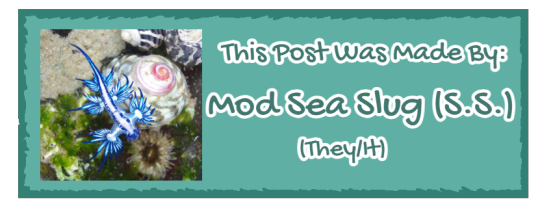
A fin appears above the water...
Name(s): Venice◞ Venix◞ Rowan◞ Birch◞ Quinn◞ Aspen◞ River◞ Charlie◞ Dove◞ Rat◞ Fawn/Faun◞ Lynx◞ Raven◞ Finch◞ Sage◞ Ellis◞ Finley◞ Mildred◞ Froggie◞ Bard
Nickname(s): Venn◞ Nix◞ An◞ Riv◞ Eli/Ellie◞ Finney
Age: Ageless, appears 17-18
Gender: Nonbinary◞ Cryptidgender◞ Mythogender
Pronouns: They/Them◞ It/Its◞ Crypt/Cryptid◞ Bite/Bites◞ Fer/Fers/Feralself◞ Lurk/Lurks◞ One/Ones◞ Weird/Weirds◞ Odd/Odds◞ Spook/Spooks◞ Secret/Secrets◞ Hide/Hides◞ Thing/Things
Sexuality: Asexual◞ Bisexual
Source: Cryptid - Madilyn Mei◞ Madilyn Mei
Role(s): Housekeeper
Front Triggers: Forests◞ hikes◞ large open spaces
Personality: Venice is a generally quiet person, quiet enough that sometimes people don't realize fer's there. They can often be found exploring outdoors, drawing things (especially trees and bugs) or picking up trash in the forest, oftentimes singing to themselves while they work. If someone talks to them, secret may be skittish at first, but hide likes to talk about their interests a lot. Lurk also likes pretending they're in a fantasy land and running around 'finding treasure'.
Aesthetic/s: Goblincore◞ Cottagecore


Quote/s:
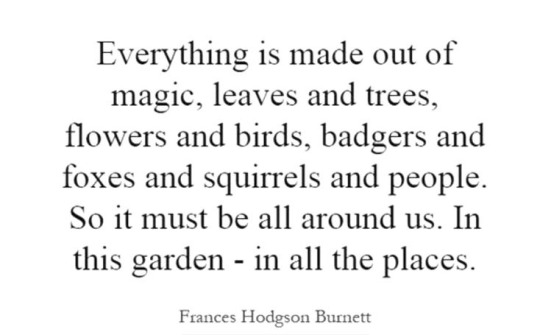
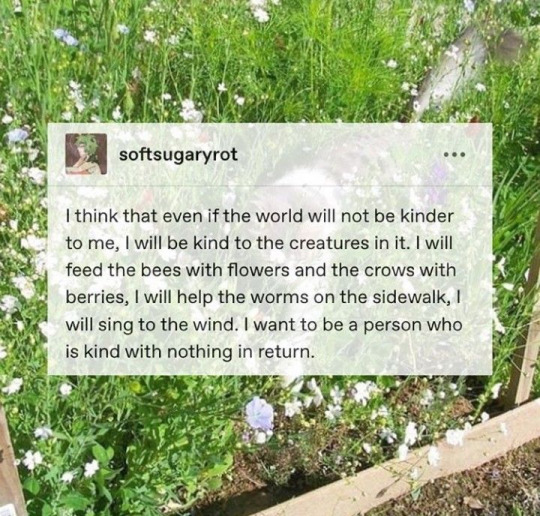
Likes: Forests◞ beach/forest cleanups◞ hiking◞ camping◞ adventures◞ D&D◞ musical instruments (usually ukeleles)◞ freedom◞ animals◞ warm weather◞ watching the sunset◞ singing◞ drawing◞ pretty rocks
Dislikes: Littering, forest fires◞ rude people◞ pollution
Songs: Cryptid (Madilyn Mei)◞ Boys Will Be Bugs (Cavetown)◞ my dear friends (Beetlebug)◞ Kid & Leveret (YAELOKRE)◞ Tree Hugger (Kimya Dawson & Antsy Pants)◞ Army Dreamers (Kate Bush)◞ The Milk Carton (Madilyn Mei)◞ I Want To Meet Your Dog (Cavetown)
Banners:
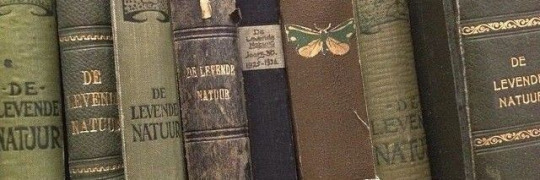


Quirks: Fidgets with their hair a lot and chews on their sleeves.
Typing Example: "nice to meet you...i'm venice, and..welcome to disney channel?"
Handwriting Example:
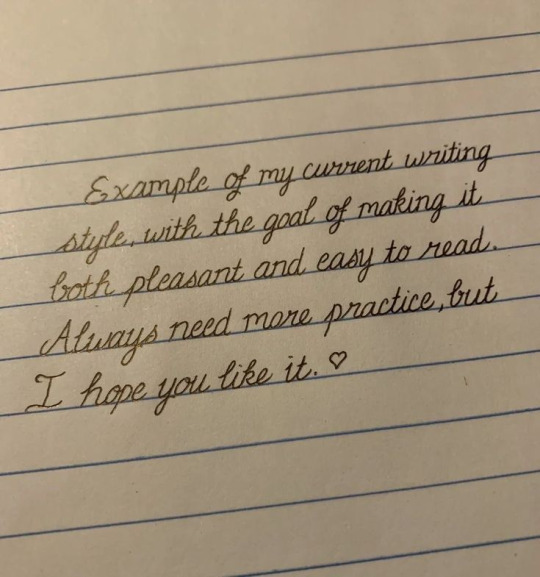
Voice Example: Here!
Faceclaim/s:


Other: Picks up any trash they might find.
4 notes
·
View notes
Text
This is actually absolutely amazing.
youtube
So the tl;dr of this stuff.
Think of proteins as nature's home grown biodegradable nanomachines that can do all kinds of absurd shit that sounds like it's from a videogame.
And in short, after they developed ways to distiguish and tell proteins at a glance from one another, creating a catalogue and database using artificial intelligence and even the ability to recreate and synthesize them in nature, we can do something absolutely amazing.
We can make custom proteins, now. The ramifications for medicine, agriculture; it's absolutely staggering just how much this is going to change in exactly how many areas.
Imagine being able to synthesize any given protein we usually get from rare and exotic animals, like horseshoe crabs. Horseshoe crab blood is very useful in medicine. Why? Because of things they produce in their blood. Why? Because nature naturally selected to do that for that purpose. Some qualities in their blood, the proteins, made them uniquely suited for stuff. Their scarcity meant we could only use so much, which meant higher price. And likewise for so many other animals, or bacteria. All enzymes and proteins and such.
Antivenins and it's not impossible that we'll be able to manufacture blood in such volumes that blood drives never need to be had, again.
Radioactivity resistant proteins that could make a person more resilient in contaminated areas.
Everything animals in nature do? It's all fucking proteins. It's all fucking biodegradable and benign to the rest of the meat being around them. And now we have a way to near instantly intimately know every protein and what it chemically does in an organism with near 100% comprehension. Whereas before we were plodding along with multi-year long excursions just to document singular proteins.
And now we'll be able to have that stuff practically on TAP. Every little chromo and ribosomal machine swimming about in animal blood is now collectible and synthesizable and tweakable and can be put to work outside a singular organism's body. For medicine, for pollution cleanup, for nutrition, for sanitation of everything from tools, to machinery, to environments, for manufacturing.
You're going to see this the most in energy and healthcare and it's going to smash older models hard, for higher dividends, less work and greater yields. Exactly how is worth longer paragraphs by people that know much more than I do, but I know enough to know we've crossed a massive fucking threshold here.
4 notes
·
View notes
Text
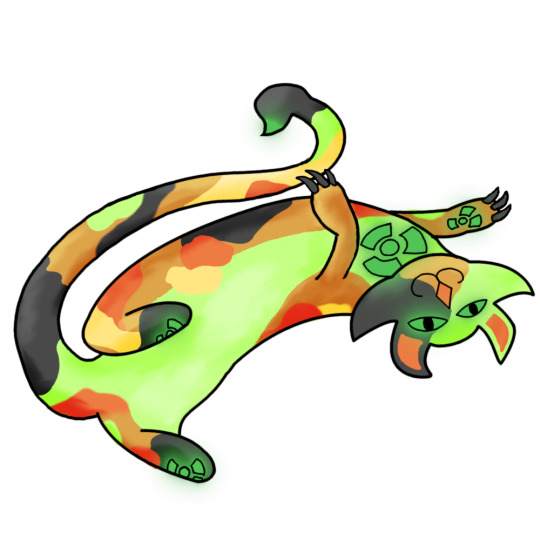
Caliglo, the Warning Pokemon Following the train derailment outside Bascule City, a great deal of hazardous material was left in the area. We have confirmed this is the cause of the recent outbreaks of caustic rain in the area, but this detail is not to be released to the public. The toxic air around the breached and spread materials has made cleanup difficult. One good thing has come of the disaster, however. A population of feral Calicozy had lived in the impact zone, and has adapted to the hostile environment rather than expire. Legal and Marketing are currently trying to figure out ways we can copyright these without raising the ire of the entire region. The Pokemon, currently codenamed "Caliglo" exhibits behavior far different from the other polluted specimens, in particular it is able to breed and evolve without extreme methods. Caliglo appears to be a natural evolution of Caliglo in the face of a new environment, such as the changes in Manakan Sneasel, or the evolution of Eevee around the mythical "Moss Rock." Caliglo are extremely tough, and completely immune to the toxic environment in the crash area. Even in areas of low contamination, the green patches on Caliglo's coat glow, alerting everyone to the nearby danger. This glow intensifies with contamination level, letting them be used as living sensors to help teams get deeper into the area with relative safety. The green color is muted outside the contaminated area, allowing the Pokemon to exist in most public spaces under the guise of being a particularly chubby Calicozy. Because of this, we have been planting Caliglo in important positions to be on the lookout for the contamination.
Types: Poison/Dark Ability: Geiger Counter — As Pokemon take damage from poison, Caliglo increases its most proficient stats in sequence. Toxic poison raises by two stages instead. [Best stat the first tick, second best the second tick, start at the best stat again on the sixth tick] Hidden Ability: Corrosion Evolution: Calicozy evolves into Caliglo when it levels up in an irradiated area. Gender Split: 75% Female, 25% Male Egg Group: Field; Unlike Calicozy, male Caliglo can breed.
No one at Glo-Co is watching on account of the holidays, go, quick, spread the word while we can! I'm going to try to get more documents before they realize what's going on.
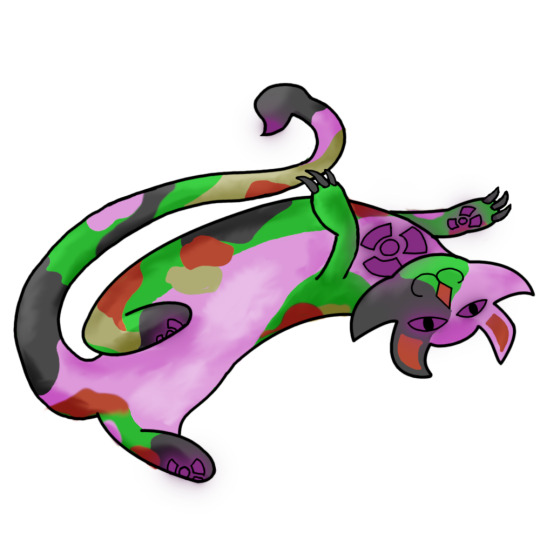
#doodle#by-cajun#poke-midwest#glo-co#fakemon#dex-entry#shiny#signature-ability#caliglo#calicozy-line#two-stage
5 notes
·
View notes
Text
Excerpt from this New York Times story:
During his cabinet meeting on Wednesday, President Trump casually mentioned that Lee Zeldin, the administrator of the Environmental Protection Agency, intended to fire 65 percent of employees, an incision so deep that officials said it would hobble the E.P.A.
Mr. Trump said Mr. Zeldin “thinks he’s going to be cutting 65 or so percent of the people from environmental. And we’re going to speed up the process, too, at the same time.”
Within minutes, managers at the agency said they received a White House memo telling them to prepare for mass layoffs.
The memo, which was sent to leaders of multiple agencies, said that the federal government “is costly, inefficient, and deeply in debt.” It did not mention the 65 percent goal, but laid out steps for the E.P.A. to prepare for what is known as a reduction in force, which would result in eliminating jobs.
Hours later, an E.P.A. official said Mr. Trump was referring to overall agency budget cuts and not a 65 percent reduction in personnel.
The E.P.A. had 15,123 full-time employees at the end of December, according to the latest budget. A reduction of 65 percent would mean the loss of nearly 10,000 jobs, which would devastate the agency responsible for clean air and clean water, said Marie Owens Powell, the president of the agency’s biggest union, the American Federation of Government Employees.
Ms. Owens Powell said the administration had not informed the union about its 65 percent goal and that she had heard about it first from Mr. Trump on television.
“This is so much bigger than just 65 percent of the employees,” she said. “What does it really mean? It means 65 percent less people available to respond to natural disasters, which are happening more frequently, not less. It would mean 65 percent less people to respond to hazardous cleanups, to do air monitoring and lead abatement.”
Nicole Cantello, president of federation’s Local 704, which represents employees in the Midwest, said the result was that “polluters would have a holiday.”
21 notes
·
View notes